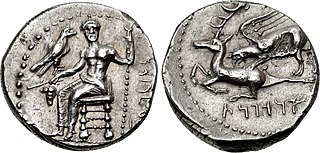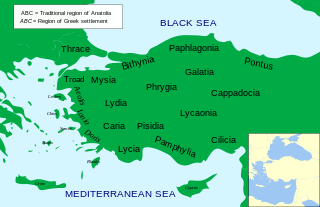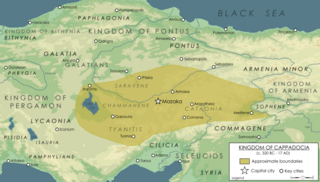This article relies largely or entirely on a single source .(March 2023) |
This article lists the Hellenistic princes and kings of Cappadocia , an ancient region in central Anatolia.
This article relies largely or entirely on a single source .(March 2023) |
This article lists the Hellenistic princes and kings of Cappadocia , an ancient region in central Anatolia.
The hitherto satrap, Ariarathes I managed to keep control of most or all Cappadocia, as independent prince leading the resistance against conquerors, even after Alexander the Great's conquest of the Persians; however, in 322 BC, he was crucified by Perdiccas, Alexander's general and (after Alexander's death) regent.
Perdiccas gave Cappadocia to Eumenes, Alexander's former secretary. However, during the instability of the ongoing Wars of the Diadochi, Eumenes was killed, and then the regent Antigonos was killed.
Ariarathes I's adopted son, Ariarathes II, managed to re-secure some of his inheritance, namely the mere Upper Cappadocia around Mazaca, and became Prince of Cappadocia (while accepting Seleucid suzerainty). The Lower Cappadocia was lost forever to Kingdom of Pontos which emerged since 301 BCE in the coast of Black Sea, and proclaimed Kingdom in circa 281 BCE.
Possibly continuing a while under weak Seleucid suzerainty, title recognized as Kings:
| Camissares satrap of Cappadocia | |||||||||||||||||||||||||||||||||||||||||||||||||||||||||||||
| Datames satrap of Cappadocia | |||||||||||||||||||||||||||||||||||||||||||||||||||||||||||||
| Ariamnes satrap of Cappadocia ARIARATHIDS | |||||||||||||||||||||||||||||||||||||||||||||||||||||||||||||
| Ariarathes I satrap 350-331 BC, later king of Cappadocia 331-322 BC | Holophernes | ||||||||||||||||||||||||||||||||||||||||||||||||||||||||||||
| Ariarathes II king of Cappadocia 301-280 BC | Antiochus II Theos | ||||||||||||||||||||||||||||||||||||||||||||||||||||||||||||
| Ariamnes king of Cappadocia 280-230 BC | Seleucus II Callinicus | ||||||||||||||||||||||||||||||||||||||||||||||||||||||||||||
| Ariarathes III king of Cappadocia 255-220 BC | Stratonice daughter of Antiochus II Theos | Antiochus III the Great | |||||||||||||||||||||||||||||||||||||||||||||||||||||||||||
| Ariarathes IV king of Cappadocia 220-163 BC | Antiochis | ||||||||||||||||||||||||||||||||||||||||||||||||||||||||||||
| Stratonice ∞ 1.Eumenes II ofed Pergamon 2.Attalus II of Pergamon | Orophernes Nicephorus king of Cappadocia 157 BC | Ariarathes V Eusebes Philopator king of Cappadocia 163-130 BC | Nyssa daughter of Pharnaces I of Pontus | Mithridates V king of Pontus | |||||||||||||||||||||||||||||||||||||||||||||||||||||||||
| Ariarathes VI Epiphanes Philopater king of Cappadocia 130-116 BC | Laodice | Mithridates VI king of Pontus | Monime | Ariobarzanes I Philoromaios king of Cappadocia 95-c.63 BC ARIOBARZANIDS | Athenais Philostorgos I | ||||||||||||||||||||||||||||||||||||||||||||||||||||||||
| Nysa ∞ Nicomedes III of Bithynia | Ariarathes VII Philometor king of Cappadocia 116-101 BC | Ariarathes VIII Epiphanes king of Cappadocia 101-96 BC | (illeg.) Ariarathes IX Eusebes Philopator king of Cappadocia 101-96 BC | Athenais Philostorgos II | Ariobarzanes II Philopator king of Cappadocia c.63-c.51 BC | Isias Philostorgos ∞ Antiochus I of Commagene | |||||||||||||||||||||||||||||||||||||||||||||||||||||||
| Ariobarzanes III king of Cappadocia 51-c.42 BC | Ariarathes X Eusebes Philadelphos king of Cappadocia c.42-36 BC | ||||||||||||||||||||||||||||||||||||||||||||||||||||||||||||

This article concerns the period 329 BC – 320 BC.

Perdiccas was a Macedonian general, successor of Alexander the Great, and regent of Alexander's empire after his death. When Alexander was dying, he entrusted his signet ring to Perdiccas. Initially the most pre-eminent of the successors, Perdiccas effectively ruled Alexander's increasingly unstable empire from Babylon for three years, until his assassination, as the kings he ruled for were incapable.

Antigonus I Monophthalmus was a Macedonian Greek general and successor of Alexander the Great. A prominent military leader in Alexander's army, he went on to control large parts of Alexander's former empire. He assumed the title of basileus (king) in 306 BC and reigned until his death. He was the founder of the Antigonid dynasty, which ruled over Macedonia until its conquest by the Roman Republic in 168 BC.
Ariarathes was the name of ten Hellenistic kings of Cappadocia in Anatolia, between the 4th and 1st centuries BC. They are:

The Wars of the Diadochi or Wars of Alexander's Successors were a series of conflicts fought between the generals of Alexander the Great, known as the Diadochi, over who would rule his empire following his death. The fighting occurred between 322 and 281 BC.

Ariarathes V Eusebes Philopator was a son of the preceding king Ariarathes IV of Cappadocia and queen Antiochis. He was distinguished by his contemporaries for the excellence of his character and his cultivation of philosophy and the liberal arts and is considered by some historians to have been the greatest of the kings of Cappadocia.

Ariarathes IV, surnamed Eusebes, "the Pious",, was the king of Cappadocia in 220–163 BC.

Ariaramnes, was the Ariarathid king of Cappadocia from 280 BC to 230 BC. He was the son and successor of Ariarathes II.

Ariarathes II, satrap and king of Cappadocia, son of Holophernes, fled into Armenia after the death of his uncle and adopted father Ariarathes I, ruler of Cappadocia. After the death of Eumenes he recovered Cappadocia with the assistance of Ardoates, the Armenian king, and killed Amyntas, the Macedonian satrap, in 301 BC, but was forced to accept Seleucid suzerainty. He was succeeded by Ariaramnes, the eldest of his three sons.

Ariarathes I was the last Achaemenid Persian governor (satrap) of the province (satrapy) of Northern Cappadocia, serving from the 340s BC to 331 BC. He led defensive efforts against the Macedonian invasion, commanded by Alexander the Great, and later fought at the Battle of Gaugamela under Darius III, the last King of Kings of the Achaemenid Empire. After the fall of the Achaemenid Empire, Ariarathes continued his resistance against the Macedonians, ruling concomitantly as an Achaemenid remnant and a precursor to the Kingdom of Cappadocia. He is regarded as the founder of the Iranian Ariarathid dynasty.

Ariarathes IX Eusebes Philopator, was made king of Cappadocia by his father Mithridates VI of Pontus after the assassination of Ariarathes VII of Cappadocia in c. 100 BC. Since he was only eight years old, he was put under the regency of the Cappadocian Gordius.

Ariobarzanes II, surnamed Philopator, "father-loving",, was the king of Cappadocia from c. 63 BC or 62 BC to c. 51 BC. He was the son of King Ariobarzanes I of Cappadocia and his wife Queen Athenais Philostorgos I. Ariobarzanes II was half Persian and half Greek.

Ariobarzanes III, surnamed Eusebes Philorhomaios, "Pious and Friend of the Romans", was the king of Cappadocia from ca. 51 BC until 42 BC.

Ariarathes X, surnamed Eusebes Philadelphos, "Pious, brother-loving", was the king of Cappadocia from c. 42 BC to 36 BC. He was of Persian and Greek ancestry. His father was King Ariobarzanes II of Cappadocia and his mother was Queen Athenais. He became king after his brother Ariobarzanes III Philoromaios was killed. His rule did not last long as Mark Antony of Rome removed and executed him, replacing him with Sisines, who became Archelaus of Cappadocia.
Athenais Philostorgos II, also known as Athenais Philostorgus II or Athenais of Pontus, was a princess of the Kingdom of Pontus, and queen of Cappadocia by marriage to King Ariobarzanes II Philopator. Her name in Greek translates to "Athenais the loving one".

Classical Anatolia is Anatolia during classical antiquity. Early in that period, Anatolia was divided into several Iron Age kingdoms, most notably Lydia in the west, Phrygia in the center and Urartu in the east. Anatolia fell under Achaemenid Persian rule c. 550 BC. In the aftermath of the Greco-Persian Wars, all of Anatolia remained under Persian control except for the Aegean coast, which was incorporated in the Delian League in the 470s BC. Alexander the Great finally wrested control of the whole region from Persia in the 330s BC. After Alexander's death, his conquests were split amongst several of his trusted generals, but were under constant threat of invasion from both the Gauls and other powerful rulers in Pergamon, Pontus, and Egypt.

Cappadocia was a Hellenistic-era Iranian kingdom centered in the historical region of Cappadocia in Asia Minor. It developed from the former Achaemenid satrapy of Cappadocia, and it was founded by its last satrap, Ariarathes. Throughout its history, it was ruled by three families in succession; the House of Ariarathes (331–96 BC), the House of Ariobarzanes (96–36 BC), and lastly that of Archelaus (36 BC–17 AD). In 17 AD, following the death of Archelaus, during the reign of Roman emperor Tiberius (14–37 AD), the kingdom was incorporated as a Roman province.
Philopator, meaning "father-loving", was a common royal epithet among Hellenistic monarchs:
The Ariarathid dynasty was a hereditary dynasty of Iranian origin.